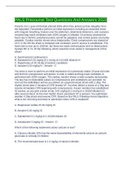Samenvatting
PROTEIN SCIENCE complete lecture summary
- Instelling
- Vrije Universiteit Amsterdam (VU)
Very detailed lecture summaries, including Guest lectures. With my summary I had scored a 8.5 on the test. I did not have enough time to summarize lecture 2 and 10. However, I included a written summary to help you understand this lecture. Guest lecture 2 and 4 are also included by a written su...
[Meer zien]













